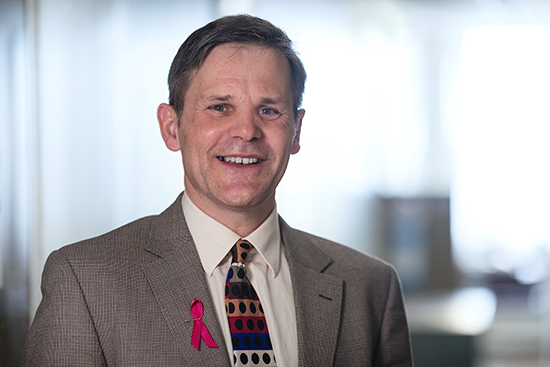Searching for the “signature” causes of BRCAness in breast cancer
By Tom Ulrich from the Broad Institute
Breast cancer cells with defects in the DNA damage repair–genes BRCA1 and BRCA2 have a mutational signature (a pattern of base swaps — e.g., Ts for Gs, Cs for As — throughout a genome) known in cancer genomics as “Signature 3.” But not all breast tumor cells exhibiting Signature 3 have BRCA1 or BRCA2 mutations. Therefore, some consider Signature 3 a biomarker for “BRCAness,” a sign of a breakdown in BRCA-related DNA repair (a process called homologous recombination, or HR) in general and not BRCA damage in particular.

Dr. William Foulkes is a cancer geneticist at the McGill University Health Centre at the Segal Cancer Center at the Jewish General Hospital. He is also a scientist in the Cancer Research Program of the Research Institute of the MUHC.
The question is, what else might deactivate HR and give rise to Signature 3? And beyond that, might Signature 3 have a role in the clinic?
To find out, an international team led by Paz Polak, Jaegil Kim, Lior Braunstein, and Gad Getz of the Broad Institute’s Cancer Program and Massachusetts General Hospital's Center for Cancer Reserach; and William Foulkes of McGill University reanalyzed data from nearly 1,000 breast cancer tumors collected by The Cancer Genome Atlas (TCGA). Their findings, reported in Nature Genetics, hint that mutational signatures like Signature 3 might fuel a precision medicine approach that uses a tumor’s full scope of mutations to guide risk and treatment decisions, instead of focusing on individual genes.
“The defects associated with Signature 3 may make patients more responsive to certain treatments,” says the study co-author Dr. William Foulkes, a cancer geneticist at the McGill University Health Centre (MUHC) and at the Segal Cancer Center at the Jewish General Hospital. “By undertaking a comprehensive genomic and epigenomic analysis of breast cancer, we have identified alterations that were not previously known to be associated with Signature 3. We are also better able to determine whether certain types of genetic variants found in a person are associated with disease, as opposed to simply being innocent bystanders.”
Among the breast tumors exhibiting Signature 3, the researchers found that:
“By undertaking a comprehensive genomic and epigenomic analysis of breast cancer, we have identified alterations that were not previously known to be associated with Signature 3. We are also better able to determine whether certain types of genetic variants found in a person are associated with disease, as opposed to simply being innocent bystanders,” says co-study author Dr. Foulkes, a cancer geneticist at the McGill University Health Centre.
Tumors with germline (inherited) or somatic (acquired) BRCA1 or BRCA2 mutations were overwhelmingly positive for Signature 3. So too were tumors with germline mutations in PALB2, a gene that works in concert with BRCA1 and BRCA2.
Defects in ATM or CHEK2 (two genes that alert the cell to DNA damage, and which can harbor breast cancer risk-raising germline variants) were not linked to Signature 3.
Expression of RAD51C (another BRCA1/2 partner) was epigenetically blocked in several tumors. This hitherto-unrecognized HR dysfunction mechanism was far more common in basal-like breast tumors from younger African-American women in the dataset than in those from white women, as was epigenetic BRCA1 silencing (a known Signature 3 driver). The reverse was true for mutation-based drivers.
“The identification of RAD51C methylation is another piece of the puzzle in trying to explain why people of African descent have an especially high incidence of triple-negative breast cancer. It could have therapeutic implications, so it is definitely a finding that calls for further investigation,” adds Dr. Foulkes who is also scientist in the Cancer Research Program of the Research Institute of the MUHC.
And what of Signature 3’s clinical utility? The team found that they could combine the signature’s presence or absence in breast cancer cells with other data to classify rare BRCA1 and BRCA2 mutations as harmful or not, a finding they noted needs to be investigated further. The researchers also suggested that Signature 3 might one day factor into treatment decisions for women with breast cancer, or help guide development of future “BRCAness”-targeting therapies.
Paper(s) cited:
Polak P, Kim J, Braunstein L, Foulkes WD, Getz G, et al. A mutational signature reveals alterations underlying deficient homologous recombination repair in breast cancer. Nature Genetics. Published online August 21, 2017. DOI: 10.1038/ng.3934.
https://www.broadinstitute.org/news/searching-signature-causes-brcaness-breast-cancer
